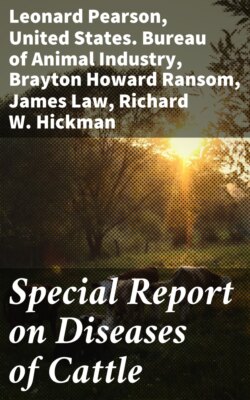Читать книгу Special Report on Diseases of Cattle - Lowe - Страница 122
На сайте Литреса книга снята с продажи.
INFLAMMATION OF VEINS (PHLEBITIS).
ОглавлениеWhen bleeding is performed without proper care or with an unclean lancet, inflammation of the vein may result, or it may be caused by the animal rubbing the wound against some object. When inflammation follows the operation, the coats of the vein become so much enlarged that the vessel may be felt hard and knotted beneath the skin, and pressure produces pain. A thin, watery discharge, tinged with blood, issues from the wound. The blood becomes coagulated in the vessel. In inflammation of the jugular the coagulation extends from the wound upward to the first large branch. Abscesses may form along the course of the vein. The inflammation is followed by obliteration of that part in which coagulation exists. This is of small import, as cattle have an accessory jugular vein which gradually enlarges and accommodates itself to the increased quantity of blood it must carry.
Treatment.—The treatment for inflammation of the vein is to clip the hair from along the course of the affected vessel and apply a blister, the cerate of cantharides. Abscesses should be opened as soon as they form, because there is a possibility of the pus getting into the circulation.
In the operation of bleeding the instruments should be clean and free from rust. If the skin is not sufficiently opened, or when closing the wound the skin is drawn out too much, blood may accumulate in the tissue, and if it does it should be removed by pressing absorbent cotton or a sponge on the part. Care should also be used in opening the vein, so that the instrument may not pass entirely through both sides of the vein and open the artery beneath it.
